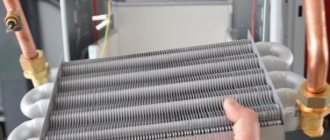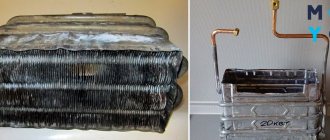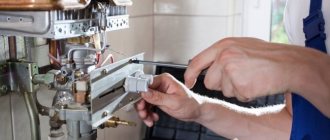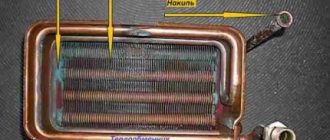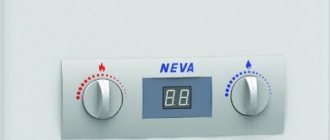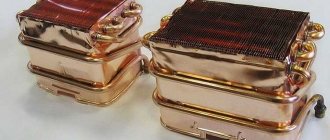A geyser is a compact, functional, practical and reliable device for providing an apartment with hot water. It will not take up much space on the wall, and any teenager can understand the principle of operation of the device. The equipment is durable, practical, reliable, durable, and will serve the owner for decades.
The main thing is not to forget about the need for regular maintenance, namely, periodically cleaning and repairing the unit if necessary. In practice, a geyser can last much longer than its rated life if it is properly maintained. Where does scale and soot come from, what is needed to remove them, how to clean the main working parts of the device, read the review.
The nature of geyser pollution
Next you will learn how to clean a gas water heater yourself, but for now let’s figure out where the problem actually comes from. The main reason for contamination is the design and operating principle of the device. The device uses gas to heat water, so the appearance of soot and soot cannot be avoided. The ignition element itself can also become dirty - it collects soot on the wick.
But the main problems begin when a thick layer of scale forms in the pipes of the water heating device. It prevents the equipment from working normally and can completely damage the installation or clog the water supply network.
The presence of scale inside the heat exchanger is especially dangerous. The heat exchanger in the water heating column is represented by a set of tubes that are located above the burner. Water must flow through them without obstacles, otherwise it will heat unevenly. Any accumulation of contaminants leads to the device operating intermittently.
Disturbances in the operation of the column and their elimination
If your water heater suddenly leaks, sometimes the reason is worn out gaskets. When removing the casing, it becomes clear whether this assumption was justified. Having found a fistula in the heat exchanger, many consumers are interested in how to replace the problematic part. But the difficulty is that the price of spare parts reaches 30% of the price for a completely new heater.
It is much more practical to solder a mechanical defect using a soldering iron. Solder melts at about 200 degrees. The exact value is determined by the brand of the specific part. Even if the water boils for a long time, it will not damage the integrity of the “patch.” This solution is equally relevant for Russian and foreign speakers. After all, the risk of breakdown is present everywhere, only the service life differs, but defects will still appear in any model.
How does such a unit work?
When cleaning the Neva gas water heater with your own hands and other brands, you need to take into account the design features of such units. Visually, they look like a large iron box with pipes – one for gas, the other for cold water.
Inside the case there are:
- Igniter;
- Burner;
- Heat exchanger for hot water supply.
The unit operates as follows. First, the user opens the hot water tap, at which time the ignition in the column is automatically turned on. The igniter is turned on - it ignites the main burner, and it begins to heat cold water in the heat exchanger until the set temperatures are reached. A similar principle is used by most boiler models.
Important! On a gas water heater, ignition can be electric or piezo.
From a design point of view, modern heat exchangers are extremely well thought out. For example, the heat exchanger from the column has the shape of a coil (spiral), which guarantees the fastest heating of the water before it is supplied to the tap. Combustion products are immediately removed from the room through the chimney into the ventilation. Cheap models do not always contain output, which is their main drawback. Therefore, when choosing equipment, take into account all the main factors - this will help you make the only right choice of equipment and prevent unnecessary expenses in the future.
Full disassembly service
Do not be afraid to disassemble the water heating installation, the procedure is not that complicated. You will need the most common tools - screwdrivers, pliers, standard wrenches. What to do before starting work:
- Close the taps of the cold water, hot water and gas supply pipelines. Unplug the turbocharged dispenser from the outlet.
- Substituting the container, unscrew the union nuts (American) on the connection of the water pipes. Disconnect the connections from the unit without losing the rubber gaskets.
- For convenience, it is recommended to remove the gas heater from the wall. It is not easy to disassemble and clean a unit that is hung too high or installed in a narrow niche.
- To dismantle the water heater, disconnect the gas line and the chimney pipe. Remove the unit from the hooks.
Symptoms of malfunctions
The following signs indicate that the column is clogged:
- The burner does not light well and a loud bang may be heard;
- The heater starts, but the burner goes out almost immediately;
- Soot is pouring out from under the casing below;
- The unit operates at maximum capacity, but the water barely heats up.
Recommendations on how to clean the heat exchanger of a geyser or igniter will be different, so you need to immediately understand what and where exactly the problem is. So cotton in the chamber indicates that excess gas is accumulating before ignition.
In this case, look for instructions on how to clean the igniter, which is responsible for the timely ignition of fuel. If the flame is very weak and has a pronounced yellow color, the nozzle is clogged. The ignition unit in most models can be easily disconnected from the main burner, and then calmly remove all debris.
The draft and overheating sensors are triggered by the accumulation of excessive amounts of soot. It is concentrated between the fins of the heat exchanger. At the same time, the cross-section of the gas-air path decreases, and operating temperatures increase. In this case, you need a liquid to clean the heat exchanger of the geyser from soot.
If flakes literally fall out from under the decorative apron, you should clean the gas water heater immediately.
If cleaning the gas water heater heat exchanger does not give the required results, check the main burner. Soot can clog its nozzles, and again, proper heating is not produced. The gas column burner and the heat exchanger are closely connected, so it is advisable to carry out preventive maintenance of both units at the same time.
The heat exchanger of the geyser must be cleaned of scale in order to restore the normal flow area. Any deposits on the walls reduce it and negatively affect the functionality of the device.
“Overgrowing” of the internal pipe passages is indicated by a decrease in water pressure at the outlet of the device at normal inlet pressure. The salts in tap water cannot be removed anywhere - and it is they that lead to clogging of the pipe passages. Over time, as a result of their natural deposition, the walls become clogged, and the plaque becomes very thick and durable. In this case, cleaning the geyser heat exchanger using the flushing method helps.
Let's summarize when maintenance needs to be done (and the sooner the better):
- The device quickly goes out during operation or does not turn on at all. First check the gas supply - if there is no problem, make sure there is sufficient water pressure. When the pressure is also stable, test the ignition element. If there is a thick layer of burning and soot, it will not work normally until the contaminants are removed. The solution to the problem is cleaning the burner.
- Constant activation of the thermal protection of the device - in order to prevent the equipment from overheating, it is equipped with a heat sensor. This sensor signals critical temperature increases and warns the owner about equipment malfunctions. When the sensor is triggered too often, it makes sense to clean the pipes and burner.
- Thermal protection is triggered - a sensor in the column is provided to ensure that the equipment does not overheat and, accordingly, does not fail prematurely. It signals an increase in current indicators above critical levels. If the sensor triggers frequently, check the pipes - scale most likely has accumulated there. Since scale has good thermal insulation properties, the device overheats and turns off.
- The productivity of the device has decreased significantly for unknown reasons - for example, the water began to heat up slowly, and the pressure dropped sharply. It is necessary to test the heat exchanger for the presence of scale and remove all deposits from the working parts of the device.
We have figured out the causes and signs of blockages, now let’s see how to clean a gas water heater with your own hands, and what is needed for this.
Why does soot appear?
Caring for the speaker primarily involves cleaning it from soot. You can perform the procedure yourself, using a cleaning product and following simple rules, or contact a specialist. Clogged nozzle holes can be easily pierced with a wire brush or thin wire.
The column needs to be cleaned regularly - according to reviews, the nozzles in most models clog quickly, and the igniter also requires regular maintenance. Regular cleaning of the igniter of a Bosch and other brands of gas water heater will avoid costly repairs in the future, since this procedure extends the life of the unit.
Every equipment owner should know how to clean the burner in a gas water heater, since problems with igniters occur in models. But if the device constantly goes out, for unknown reasons, and nothing helps, it would be better to contact service.
Soot may appear due to leaks in the gas supply pipe. With a minimal release of gas masses, there will be practically no odor, and the user will not understand anything. You can check the system like this - apply a soap solution to the pipe connection areas with a brush, turn on the column and see how it behaves. If bubbles appear, there is a problem. Options for how to clean a gas water heater at home will not help here - call a gas technician.
The next potential problem area is a clogged radiator. It often causes increased accumulation of soot. The easiest way to clean a speaker radiator is with a vacuum cleaner; any model will do.
Turn off the gas supply, remove the casing from the column, and remove the soot. If this still doesn’t help, check the draft by turning off the gas and holding a lighter or candle. Normally, the flame should deflect or go out. If the candle burns as if nothing had happened, the chimney needs cleaning. When the device has a forced draft fan, such problems do not arise in principle.
Cleaning the injectors
If the column begins to burn weakly, most likely the nozzle is clogged. You can find it on the gas manifold near the pressure sensor. For cleaning, use a thin wire or a stiff brush.
After the work is completed, it is necessary to check the column and eliminate the possibility of gas leakage. To do this, lubricate the burner with soapy water and make sure there are no bubbles.
If the nozzles are clogged, the gas begins to burn weaker and the device stops heating the water.
How to remove soot from a heat exchanger
We wrote above where the heat exchanger is located; before starting maintenance, it is advisable to remove it from the unit, first turning off the gas and water, opening the tap for supplying hot water (the one located near the flow-through heater). Then, using a gas or open-end wrench, loosen the nut securing the tube to the water unit and unscrew it slightly (a couple of turns will be enough). The contents must be allowed to flow out through the mixer, which is left open.
Helpful advice. Before cleaning the geyser from scale, prepare a special tool and products. The most convenient way to solve the problem is to use an aerosol agent to loosen boiled threaded joints. You can ask for the WD40 product at any auto store or hardware store.
How to clean the geyser heat exchanger further:
- Unscrew a couple of union nuts and dismantle the assembly.
- Disassemble other elements and parts that prevent easy dismantling. Their number depends on the specific model and design features of the column. In some cases, it is necessary to remove the smoke exhaust diffuser, in others - the ignition group, in others - overheating and draft sensors. You may have to remove all the parts.
- Cover the burner nozzles with a cloth to prevent soot from getting into them.
- Take the heat exchanger to the bathroom, thoroughly clean it with a long-bristled brush to remove all soot, rinse and dry.
- Return the unit to its place and reassemble the unit in the reverse order described above.
Do not forget to install new seal rings at the pipe connections. Cleaning a geyser is not difficult; most of the time is spent on assembly and disassembly. Work must be carried out strictly according to the rules. If you are not sure that you will do everything as needed, call a specialist.
Helpful advice. If the installation is clogged, you have already removed the heat exchanger, it makes sense to immediately rinse and clean the gas water heater from scale. Maintenance will be more efficient and will not take much extra time.
Before starting the unit, you need to check it for leaks. To do this, open the water supply tap and wait until the heat exchanger is filled from the open mixing tap. Then the supply is closed again, and the unit is inspected to determine the degree of permeability of its connections. If there are no serious problems, the gas valve is re-opened and the apparatus is started up for testing in standard operating mode.
Use liquid for flushing and softening connections during maintenance at your discretion. Chemistry simplifies the work, but it is not necessary to use it.
Flushing helps not only from carbon deposits, but also from dust.
Principles of cleaning
To clean the column from scale, you need to understand the assembly features of the device, study the instructions, prepare a cleaning solution, and a set of tools for removing screws and tightening valves.
To clean the unit you will need:
- a set of keys;
- screwdrivers;
- rubber hose up to 1 m;
- set of paronite gaskets;
- funnel;
- folk or chemical means for descaling.
In the first element, water is heated, which comes from the water supply when the wick-burner is started. Combustion products exit through the ventilation hole.
Elements must be cleaned according to the algorithm:
- heat exchanger;
- water supply unit;
- jets;
- other constituent components.
The process of removing scale is not complicated; the main thing is to correctly tension the membrane during the assembly process so that it springs, but does not hang down or is tightly fixed. When cleaning a gas water heater for the first time, it is recommended to act under the supervision of a specialist.
How often to clean the column
The geyser needs to be serviced at least once every 2-3 months, visually inspecting the surface of the parts. Once every six months, clean the unit using folk remedies or household chemicals.
Do I need to remove and disassemble the column?
To thoroughly rinse the heating device, you need to remove and disassemble it. Open the housing, inspect the filter, membrane, radiator, clean using chemicals or traditional methods. To reduce the appearance of scale, which will allow you to disassemble and clean the entire column less often, you can wash the radiator once every 2 months without removing it.
Cleaning the heat exchanger without removing it
To carry out the procedure you need:
- Disconnect the water supply pipe.
- Place a rubber hose onto the outlet pipe.
- Open the tap and drain a small amount of liquid, no more than a liter.
- Use household powder to clean rust, first dilute the mixture with hot water.
- Pour the solution into the pipe in a thin stream. Leave the radiator in this state for 2 hours.
- Open the tap, drain the contents, and rinse the structure.
It is recommended to use strips of corrugated paper to check whether they move or not. But the fire of a lighter or candle can be dangerous, especially if there are problems with fuel leakage.
How to clean a heat exchanger from scale
Cleaning the heat exchanger of a geyser is one of the main service works.
To begin with, the unit is removed and prepared before cleaning it. Main options:
- Special equipment care products that can be purchased in specialized stores;
- Citric acid solution (take 200 g of powder per 1 liter of water);
- Acetic aqueous solution (9 parts water, 1 part vinegar, it is better to take 9% essence).
How to clean a gas water heater using any of the following means:
- Pour the prepared solution into the heat exchanger - it is most convenient to do this using a watering can.
- Wait a few hours or leave the knot to soak overnight.
- Pour the solution down the drain.
- Rinse the heat exchanger with running clean water - you can use a water hose from the shower; you must first unscrew the nozzle.
When cleaning the unit, you cannot exceed the concentration of the products - this will not increase the efficiency of maintenance, but it can damage the unit and cause corrosion and chemical reactions. Special products are used strictly according to the instructions - they cannot be left overnight, like vinegar.
Cleaners
Craftsmen advise using hydrochloric acid to clean the radiator, but this composition causes an additional oxidation reaction upon contact with metal and destroys the surface of aluminum/copper structures.
Folk
Folk remedies cope no less effectively with the task of cleaning the radiator and other parts of the device.
Citric acid is used effectively (500 ml of liquid per 60 g of product).
- Fill the basin one-third full with water and place it on the stove.
- Place the radiator and fill with solution.
- Warm up the container for about 30 minutes.
- Rinse the unit and other components with running water.
Similarly you can use:
- Vinegar (0.5 l water per 150 g acid).
- Soda (pour 200 g of soda into the drain hole, then pour in ½ cup of vinegar).
It is not recommended to clean an aluminum heat exchanger with such compounds so as not to damage the walls of the device. In the presence of “heavy” contamination, several procedures will be required using a new portion of the cleaner.
Household chemicals
Professional cleaning products are used to remove heavy stains
It is important to observe safety rules and follow the operating instructions indicated on the packaging
Safe chemicals for cleaning the unit yourself:
- Neva;
- Electrolux;
- Bosch;
- Oasis;
- Vector;
- Anti-Scaling.
To clean the heat exchanger, proceed as follows: connect a funnel to the pipe, into which you gradually pour the solution. As soon as the pressure on the other side of the pipe increases, the job is done. All that remains is to rinse the unit.
Option for cleaning the water intake unit
We figured out how to clean the burner of a gas water heater, what to use and how to flush the radiator. The last point in the review is cleaning the water inlet assembly. It contains a strainer that prevents large pieces of rust and other deposits from clogging the pipes. It is imperative to check the membrane tension - if it is insufficient, there will not be sufficient draft from the gas water heater after turning on the water tap.
How to clean the column if the water intake unit is clogged:
- Remove the unit from the device.
- Unscrew the screw part and open the housing.
- Clean the filter under a powerful running stream of water.
- Check the membrane - if there are bulges, the part has served its purpose and needs to be replaced, it would be best to install a silicone product.
- Close the water inlet cover, preferably using screws. This will ensure maximum uniform tension.
You can only clean the jet nozzles yourself - in other situations you will need the help of a professional technician. The plumbing component is not so complicated and allows for “household” interventions. The main thing is to follow the basic rules and follow the established standards of work.
Results
You can clean the geyser yourself - the main thing is to follow the basic rules. You can descale the radiator with your own hands, replace the old filter in the gas water heater, restore the functionality of the heat exchanger, and clean the nozzles. The main thing is to follow the instructions for assembling and disassembling the unit in order to avoid serious mistakes that could damage the device. Regular maintenance will prevent serious damage and significant costs in the future.
If you understand that you cannot solve the problem yourself, contact a specialist. You also need to remember that it is one thing to remove scale from a geyser formed from rusty water, or to clean a radiator, and another thing to solve specific problems associated with draft and so on. In the case of public utilities, who should clean the dispensers is the gas worker.
Cleaning methods
Cleaning a gas water heater does not always mean complete disassembly, down to the screw. But one issue is the prevention of a completely serviceable unit, and a completely different one is the removal of many years of scale from the coil and soot from the burner.
A instantaneous water heater can be serviced in the following ways:
- completely disassemble the column, clean the gas burner device and rinse the copper heat exchanger;
- flush the radiator without disassembling;
- clean the working elements of the unit from soot and contaminants - igniter, electrodes, water unit (in common parlance - “frog”).
Note. The passage holes of the “frog” become clogged quite rarely. Usually they are cleaned when it is necessary to disassemble and repair the water unit, for example, to replace an unusable membrane.
Diagram of an instantaneous water heater using natural gas
If the device has been operated for many years without maintenance, the channels are half clogged with scale, and the flame of the gas burner has turned yellow from blockages, then the first option is definitely implemented - complete disassembly. A similar decision is made when it is necessary to solder a leaky radiator.
Preventative flushing of the heat exchanger of a household water heater is carried out without dismantling (method No. 2). Local soot removal (option No. 3) is carried out when the ignition system malfunctions - the igniter barely burns, there is no spark at the electrodes, loud pops are heard in the combustion chamber when the burner starts.
